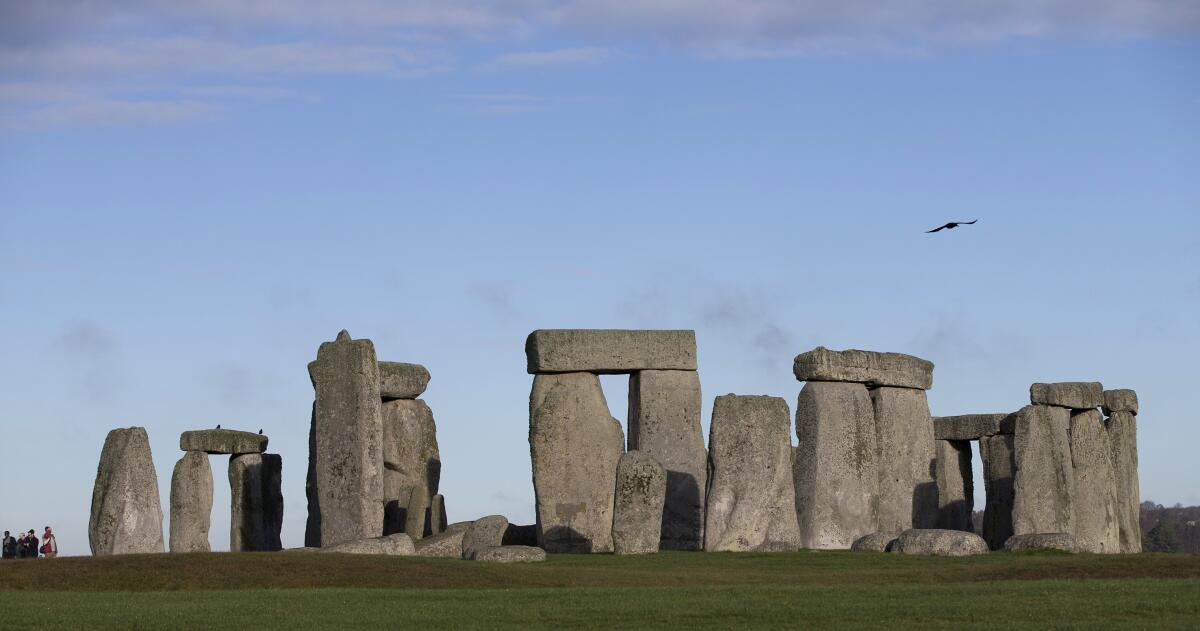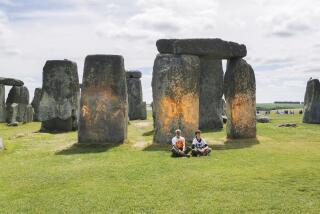Stonehenge’s ‘altar stone’ originally came from Scotland and not Wales, new research shows

- Share via
WASHINGTON — The ancient ritual meaning of Stonehenge is still a mystery, but researchers are one step closer to understanding how the famous stone circle was created.
The unique stone lying flat at the center of the monument was brought to the site in southern England from near the tip of northeast Scotland, researchers reported Wednesday in the journal Nature. It’s not clear whether the 16-foot stone was carried by boat or through land — a journey of more than 460 miles.
“It’s a surprise that it’s come from so far away,” said University of Exeter archaeologist Susan Greaney, who was not involved in the study.
For more than a hundred years, scientists believed that Stonehenge’s central sandstone slab — long called the “altar stone” — came from much closer Wales. But a study last year by some of the same researchers showed that the stone didn’t match the geology of Wales’ sandstone formations. The actual source of the stone remained unknown until now.
For the study, the team was not permitted to chip away rocks at the site, but instead analyzed minerals in bits of rock that had been collected in previous digs, some dating back to the 1840s. They found a match in the sandstone formations of Orcadian Basin in northeast Scotland, a region that includes parts of the tip of the Scottish peninsula as well as the Orkney Islands.
“That geological ‘fingerprint’ isn’t repeated in any other area of sediment in the U.K.,” said Aberystwyth University geologist Nick Pearce, a study co-author.
Over-tourism backlash: In Instragram-favorite cities and towns across Europe, some residents have reached their limit with massive crowds of tourists.
Greaney said the difficult logistics of moving the stone such a long distance show a high level of coordination and cultural connection between these two regions of ancient Britain.
Stonehenge was constructed around 5,000 years ago, with stones forming different circles brought to the site at different times. The placement of stones allows for the sun to rise through a stone “window” during summer solstice. The ancient purpose of the altar stone — which lies flat at the heart of Stonehenge, now beneath other rocks — remains a mystery.
“Stonehenge isn’t a settlement site, but a place of ceremony or ritual,” said Heather Sebire, senior curator at English Heritage, who was not involved in the study. She said that past archaeological excavations had not uncovered evidence of feasting or daily living at the site.
Previous research has shown cultural connections — such as similarities in pottery styles — between the area around Stonehenge and Scotland’s Orkney Islands. Other stones at Stonehenge came from western Wales.
While Britain is dotted with other Neolithic stone circles, “the thing that’s unique about Stonehenge is the distance from which the stones have been sourced,” said Aberystwyth University’s Richard Bevins, a study co-author.
Larson writes for the Associated Press.
More to Read
Sign up for Essential California
The most important California stories and recommendations in your inbox every morning.
You may occasionally receive promotional content from the Los Angeles Times.










